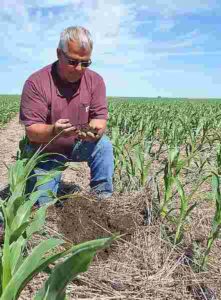Holistic Farming Definition and Practices Explained
Holistic farming is the use of biologic and physicochemical factors to achieve sustainable and economically-viable agricultural yield. This article discusses holistic farming definition and practices, as outlined below;
-Holistic Farming Definition: 5 Ways to Define Holistic Farming
Holistic Farming Definition: 5 Ways to Define Holistic Farming
Holistic farming is a type of sustainable farming that is based on the holistic approach, whereby all or most influential factors toward crop and livestock growth are taken into account in a bid to preserve natural resources and boost yield.
The above is a very basic definition of holistic farming, which takes into account the fact that it is based on the holistic approach.
Holistic approach simply means an approach that is elaborate and multidimensional, making use of as many relevant tools and factors as possible to achieve its objectives. The term may be used in any of various fields and contexts, including health, engineering, education, business, and agriculture.
In agriculture, holistic means all-encompassing, and is used to refer to any concept or practice that does not neglect any major criterion in its planning, execution and modification.
One of the attributes of holistic farming is that its is regenerative [1], and can be implemented in a bid to reverse unfavorable conditions and outcomes like resource depletion, pollution, and general loss of productivity.
This is possible through the optimization of water, soil and air quality; meaning that holistic farming can be itself a form of environmental remediation. This perspective is further highlighted in the following holistic farming definition;
Holistic farming is a remedial method of agriculture that is used to achieve soil restoration, and to regenerate natural resources, as well as protect the ecosystem from degradation.

Holistic farming is often helpful for reversal of the environmental impacts of unsustainable agriculture and other anthropogenic processes; including overgrazing, deforestation and pollution.
For such cases it functions as a means by which agricultural production may become simultaneous with ecosystem optimization.
The same concept behind holistic farming can also be used to restore degraded natural ecosystems like grasslands.
As can be deduced from the discussion so far; the success or effectiveness of holistic farming efforts, depends on the factors taken into account (which is also a reflection of how ‘holistic’ the farming practice is). Below is another holistic farming definition that highlights some factors considered in this practice;
Holistic farming is a system of agricultural management that operates by considering all factor that affect productivity; including nutrient availability, physicochemical conditions, climate, land, and scale of farming [2].
The distinctive approach that is used in holistic farming, ultimately aims at a set of expected benefits for the farmer and society at large. In the holistic farming definition below, some of these benefits of holistic farming are mentioned;
Holistic farming (also holistic agricultural management or holistic management agriculture) is a system of farming that aim to align farm crops, livestock and farming techniques with the physicochemical and biological conditions prevalent in the given area, in order to achieve soil and water conservation; manage energy resources, mitigate environmental impacts, and optimize productivity.
The benefits of holistic farming indicate its similarity to other sustainable farming principles like organic farming and permaculture; all of which employ sustainable practices like crop rotation, conservation tillage and cover cropping, to improve agricultural yield.
Lastly, holistic farming definition is given based on the mechanism behind this system of farming, in its most simple form, as follows;
Holistic farming is an agricultural system, principle and practice that works by viewing the farm as an elaborate entity whose performance and sustainability depend on multiple factors; and aims to satisfy the needs of the farm based on these factors.
Some concepts that are related to holistic farming include water conservation, soil conservation, energy efficiency, soil restoration, sustainable development, sustainable farming, and energy conservation.
Holistic Farming Practices
Holistic farming practices are;
1). Crop rotation
2). Cover cropping
3). Conservation tillage
4). Composting
6). Monitoring
Holistic Farming Principles
Holistic farming principles are;
1). Resource conservation
2). Impact mitigation
3). Biodiversity preservation
4). Self-sustainability
Conclusion
Holistic farming is an elaborate agricultural approach that combines ecologic principles with farming techniques to boost productivity and protect the ecosystem.
Holistic farming practices are; crop rotation, cover cropping, conservation tillage, composting, contour cultivation, and monitoring.
Holistic farming principles are; resource conservation, impact mitigation, biodiversity preservation, and self-sustainability.
References
1). Brown, K.; Schirmer, J.; Upton, P. (2022). “Can regenerative agriculture support successful adaptation to climate change and improved landscape health through building farmer self-efficacy and wellbeing?” Current Research in Environmental Sustainability, 4, 1-13. [100170]. Available at: https://doi.org/10.1016/j.crsust.2022.100170. (Accessed 14 December 2022).
2). Hawkins, H.; Venter, Z. S.; Cramer, M. D. (2022). “A holistic view of Holistic Management: What do farm-scale, carbon, and social studies tell us?” Agriculture Ecosystems & Environment 323:107702. Available at: https://doi.org/10.1016/j.agee.2021.107702. (Accessed 14 December 2022).



